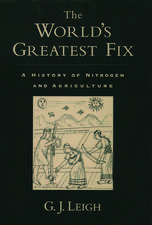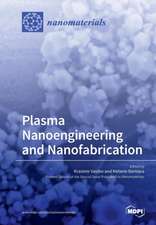The Art of Problem Solving in Organic Chemistry, 3rd Edition
Autor ME Alonso–Ameloten Limba Engleză Paperback – 18 sep 2023
Preț: 521.99 lei
Preț vechi: 652.48 lei
-20% Nou
Puncte Express: 783
Preț estimativ în valută:
99.88€ • 108.84$ • 84.17£
99.88€ • 108.84$ • 84.17£
Carte disponibilă
Livrare economică 03-17 aprilie
Livrare express 19-25 martie pentru 52.14 lei
Preluare comenzi: 021 569.72.76
Specificații
ISBN-13: 9781119900665
ISBN-10: 1119900662
Pagini: 432
Dimensiuni: 217 x 277 x 29 mm
Greutate: 1.08 kg
Ediția:3rd Edition
Editura: Wiley
Locul publicării:Hoboken, United States
ISBN-10: 1119900662
Pagini: 432
Dimensiuni: 217 x 277 x 29 mm
Greutate: 1.08 kg
Ediția:3rd Edition
Editura: Wiley
Locul publicării:Hoboken, United States
Notă biografică
Miguel E. Alonso-Amelot is Professor Emeritus of Organic and Ecological Chemistry at The University of the Andes (Universidad de Los Andes) in Mérida, Venezuela. He received his PhD from the Department of Chemistry at Indiana University and has more than 45 years of teaching experience in the United States, Europe, and Latin America. He is the author of over 110 research articles and book chapters and four books, including the first two editions of The Art of Problem Solving in Organic Chemistry.
Descriere scurtă
Cuprins
Preface ix Acknowledgements xiii Where Does This Book Level Start How Far Does It Take You? xv Part I The Toolbox 1 1 Introduction to Problem Analysis in Advanced Organic Reaction Mechanism 3 1.1 Overview 3 1.2 The First Three Steps in Problem Analysis 4 1.2.1 A Bird's Eye Overview 4 1.2.2 Change the Molecular Rendering to a Familiar Framework 4 1.2.3 Go for the Relevant, Skip the Superficial Information 5 1.3 Moving Beyond the Primary Answers 7 1.4 Drawing a Preliminary Outline for Guidance 7 1.5 Intuition and Problem Solving 8 1.6 Summing Up 9 1.7 Solution to the 14 --> 16 Conversion in Scheme I.5 10 References and Notes 10 2 Electron Flow in Organic Reactions 11 2.1 Overview 11 2.2 Introduction 12 2.2.1 A Word or Two on Notation 13 2.2.1.1 Lewis Notation and Line Renderings 13 2.2.1.2 Curved or "Curly" Arrows 14 2.3 Electrons in Covalent Bonding and Redeployment 14 2.3.1 A Preliminary Review of the Essentials 14 2.3.1.1 Electrons and Covalent Bonds: The Still Unsolved Fundamental Questions 14 2.4 Practical Rules Governing Electron Redeployment 15 2.4.1 Issue 1: Electrons Reside Within Orbitals 15 2.4.1.1 The Question of Orbital Restrictions and Electron Deployment 15 2.4.2 Issue 2: The Electron Shield Concept Contributes to Covalent Bonds 18 2.4.2.1 Carbocations 18 2.4.2.2 Carbon Dications 20 2.4.3 Issue 3: AO/MO Overlap is a Requirement for sigma and pi Bond Formation 21 2.4.3.1 AO/MO Limits and the Quantum Tunneling Effect 26 2.4.4 Issue 4: Electron Traffic and Stereochemistry 27 2.4.5 Issue 5: Electron Energy Level and Accessibility 28 2.4.6 Issue 6: Electron Flow and Molecular Active Sectors 30 2.4.7 Issue 7: Electron Flow and Compatible AO Types 32 2.4.7.1 sigma-sigma Interactions 33 2.4.7.2 sigma-pi Interactions 35 2.4.7.3 pi-pi Interactions 41 2.4.8 Issue 8: Electron Flow, Delocalization of Bonding and Non-bonding Electrons, Resonance Stabilization 44 2.4.8.1 Non-bonding Electron Pairs (NBPs) 44 2.4.9 Issue 9: Electron Traffic and Electronic Density Differences 49 2.4.9.1 Detecting Potential Donors and Acceptors 49 2.4.9.2 What Makes a Given Functional Group a Natural HEDZ or LEDZ? 50 2.4.9.3 A Reminder Takeaway 51 2.4.9.4 Quantum-mechanical Computations and Mechanism 53 2.4.10 Issue 10: Electron Traffic on Account of LEDZ Alone 54 2.4.10.1 Hidden LEDZs Triggering Deep-rooted Skeletal Rearrangements 56 2.4.10.2 Remote C-H Activation by LEDZ and Radicals 56 2.4.11 Issue 11: Inverting the Natural Electron Flow, Umpolung 59 2.4.11.1 Umpolung Successful Accomplishments 60 2.4.11.2 The Nitrogen Heterocycle Carbenes (NHC) in Carbonyl Umpolung 62 2.4.11.3 Umpolung of C=O through Imine Derivatives 63 2.4.11.4 The Hydrazone Way to C=O Umpolung 69 2.4.12 Issue 12: One-electron Flow 71 2.4.12.1 Radicals, Reminder Takeaways 71 2.4.12.2 Carbenes, Overview, and Electron Redeployment 76 2.5 Summing Up 84 2.6 Organized Problem Analysis with the Tools Described so Far 85 2.7 Supplementary Schemes: Solutions to Problems Embedded in this Chapter 86 Notes 89 3 Stereochemistry and Mechanism of Molecular Transformations 93 3.1 Overview 93 3.2 Introduction 94 3.2.1 The Question of Planar Molecules and Deviations, an Approach to Steric Effects 94 3.2.1.1 Planar 2D versus 3D 94 3.2.1.2 Perturbation of Planarity by Substituents; Approaching Steric Effects 97 3.2.1.3 Interaction of Distant C=C Bonds by Stereochemical Proximity 100 3.3 Measuring Steric Hindrance 102 3.3.1 The Roadblocks Ahead 102 3.3.2 Steric Requisites for Building sigma Bonds 102 3.3.3 Reaction Rate Retardation Due to Steric Hindrance 103 3.3.4 The Saga of Purely Steric Effects 103 3.3.4.1 Study Case 1: Substitution (S N 2) of Alkyl Bromides by Sodium Methoxide 105 3.3.4.2 Study Case 2: Hydrolysis of Esters and Esterification of Carboxylic Acids 107 3.3.4.3 Study Case 3: Connolly's Molecular Volume 109 3.3.4.4 Study Case 4: The Anilines Arylsulfonyl Chloride Model 113 3.3.4.5 Study Case 5: Other Sources of Evidence 115 3.3.5 Steric Acceleration of Reaction Rates 121 3.3.5.1 Steric Acceleration in SN1/E1 Competition during Solvolysis 121 3.3.5.2 Steric Acceleration in the Gas Phase 124 3.3.6 Summary of Steric Hindrance and Reactivity Takeaways 125 3.4 Applications to Stereochemically Competent Reaction Mechanisms 127 3.4.1 A Case of Regio and Stereoselective Reaction in a Sterically Simple Compound 127 3.4.2 The Role of Steric Umbrellas 129 3.5 Stereochemistry in Bimolecular Reactions: Cycloadditions 131 3.5.1 The Diels-Alder Cycloaddition: the CA Prototype 132 3.5.1.1 DACA Steric Domain: Essential Takeaways 133 3.5.1.2 DACA Stereoelectronic Domain: Essential Takeaways 134 3.5.1.3 Assessing Steric Effects (SEs) through Products Configuration: the Endo Alders Rule 134 3.5.1.4 The Exo : Endo Ratio and Lewis-acid Catalysis 137 3.5.1.5 Current and Future Prospects for DACA and Other Cycloadditions 138 3.6 The Ultimate Stereo- and Enantio-Control: Oriented External Electric Fields (OEEFS) 139 3.6.1 How OEEF Works 140 3.6.2 OEEF and DACA Stereocontrol 140 3.6.3 The Experimental Array 140 3.7 Summing Up 144 3.8 Supplementary Schemes 145 Notes 146 References 146 4 Additional Techniques to Postulate Organic Reaction Mechanisms 149 4.1 Overview 149 4.2 Take Your Time 150 4.3 Use Clear and Informative Molecular Renderings 150 4.4 Element and Bond Budgets 150 4.5 Looking at Molecules From Different Perspectives 152 4.6 Redraw Reactants Such That They Resemble Products 155 4.7 Fragmentation Analysis (Fa): Dissecting Products in Terms of Reactants 157 4.7.1 The Fundamental Proposition 157 4.7.2 Study Case 1 157 4.7.3 Study Case 2 158 4.7.4 Learning Lessons and Takeaways from FA 161 4.8 Oxidation Levels and Mechanism 163 4.9 The Functionality Number (FN) 164 4.9.1 What Exactly is FN? 164 4.9.2 Organizing Carbon Functionalities in FN Groups 164 4.9.3 Main FN Groups Properties 164 4.9.4 Study Case 1 166 4.9.5 Study Case 2 166 4.9.6 Study Case 3: Heterolytic C-C Cleavage and the Electron Sink 166 4.10 Combining Fragmentation Analysis and Functionality Numbers 169 4.11 A Flowchart to Orderly Exploit the Strategies of this Chapter 170 4.12 Summing Up 171 4.13 Supplementary Reaction Schemes 171 4.14 Solution to Problems Embedded in this Chapter 172 References 172 Part II The Problem Chest 173 Subject Index 389 Graphical Index 391








